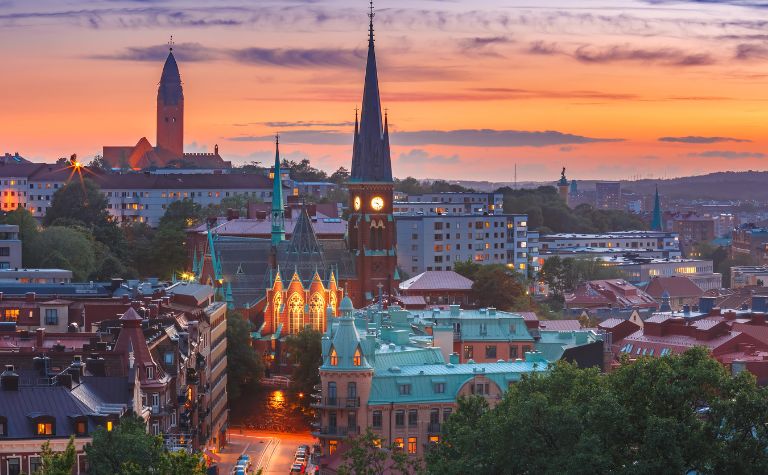In the mid-19th century, Sweden was one of the poorer countries in Europe. Yet, only a hundred years later, it had become one of the wealthiest nations in the world.
What drove this remarkable transformation in the country’s economy, and are there lessons others can learn from it?
Sweden is rich because it is a major exporter of high-value goods. It is blessed with abundant natural resources and has long enjoyed peace and stability.
The country’s proximity to the early industrialized powers of Western Europe and avoidance of the fate of colonized nations have helped.
This article will explain how Swedish wealth compares to other nations and trace its origins.
Also, see What Is Sweden Known For? to learn more.

Sweden Compared to Other Nations
According to the latest available data from the Organisation for Economic Co-operation and Development (OECD), Sweden has a per capita GDP of $60,150.
This means that, on average, individual Swedes produce 60,150 US dollars worth of goods and services in a year, making them among the top 20 richest people in the world by nationality. [1]
By comparison, the wealthiest nation on the OECD list – Luxembourg – has a per capita GDP of $134,340, and the poorest – Madagascar – $1,540.
Brazil, a middle-income country – has a per capita GDP of $15,424, and the United States of America – still the predominant world power today – has $69,558.
The data conclusively suggests that Sweden is among the very wealthiest nations in the world. In line with its Nordic neighbors, its wealth is comparable to the leading world powers.
The country has also maintained this record consistently over the past several decades and is on track to repeat its performance in the foreseeable future.
But while Sweden is clearly a very wealthy nation, this does not mean that every Swede is well off.
While the number of absolute poor in Sweden is among the lowest in the world, Statistics Sweden recently estimated that as many as 184,000 might be living under conditions of “severe material deprivation.” [2]
As an aside, the richest countries in the world are, without exception, either early European industrial powers, tiny trading and finance hubs like Singapore and Hong Kong, or oil-rich states like Qatar and the United Arab Emirates.
Also, see How Do You Move To Sweden? to learn more.

The Origins of Swedish Wealth
Sweden was not always so wealthy. Until the mid-19th century, it was poor by European standards.
For a long time, its far-northern geography had limited its ability to expand through agricultural production, and even today, less than a tenth of the land in the country is arable. [3]
The Swedes did, however, have several things going for them.
Sweden had never experienced the widespread feudal serfdom that the rest of Europe did in the Middle Ages.
This absence of an oppressed underclass of peasants and workers would later make it easier for Swedish society to build responsive institutions that its people trusted. [4]
Swedes were also among the earliest beneficiaries of the secular reform that followed in the wake of the reformation.
Apart from reinforcing the less hierarchical nature of their society, this development also encouraged the uptake of education among a larger population and unleashed their entrepreneurial drive. [5]
Equally vital was geography. The country’s abundant natural resources – especially iron ore and timber – and its proximity to early industrial hubs in England and Germany meant Sweden got a jumpstart in developing its economy.
At the same time, Sweden was never colonized and exploited for its resources like many countries in Asia and Africa.
Its people were not massacred like Native Americans and Pacific Island aboriginals.
Since the Viking Age, it has been Sweden that has been the colonizing force. It was Sweden that briefly controlled several colonies in Africa and North America.
It even ruled its Nordic neighbor Finland for several centuries during the pre-industrial era. [6]
Finally, for over 200 years now, Sweden has not gone to war. This has meant that its resources have been more productively utilized.
By avoiding war, the country has escaped the large-scale death of productive citizens and the destruction of social capital that most of Europe experienced during the two World Wars of the last century.
In the globalized era, Sweden’s high quality of human capital, infrastructure, and open economy have allowed it to benefit significantly from exporting high-value goods to the rest of the world.
While timber, iron-ore, and hydro-power contribute significantly to its economy, they are now augmented by the export of the following:
- Industrial machines
- Home appliances
- Automobiles
- Arms and ammunition
- Pharmaceutical products
- Telecommunication equipment
Today, the country is known for its extensive public sector and iconic brands such as:
- Ikea
- Volvo
- H&M
- ABB
- Ericsson
Although most businesses are owned by the private sector, the strong presence of labor unions keeps inequality relatively low and industrial relations peaceful.
The country is also known for its extensive public sector, whose transparent, well-functioning institutions have retained the trust of citizens, productively employed social capital, and provided generous social security.
For all these reasons, Swedes enjoy among the highest standards of living of any people.
Also, see What Is There To Do In Sweden? to learn more.

Major Industries of Sweden
With exports accounting for over a third of its GDP, the Swedish economy is significantly export-oriented.
The industrial engineering sector – which contributes 20% of the country’s annual GDP – accounts for 75% of all exports and provides jobs to over a million Swedish people, making it by far the most vital sector of the Swedish economy. [7]
Manufacturing within the sector includes traditional Swedish specialties, such as steel, wood products, and food processing equipment, as well as more sophisticated products, such as automobiles, pharmaceutical products, industrial equipment, and designer retail products.
A third of Swedes work in the services sector, in areas such as tourism, and export-oriented industries, such as business processes and technology consulting.
Sweden also has an extensive public sector, accounting for three-fifths of GDP.
The country collects the second-highest amounts of tax as a percentage of its income and funnels these resources into building an extensive welfare state. [8]
The state invests generously in its citizens’ health, education, and welfare.
It provides extensive child support, disability and old age pensions, unemployment benefits, and even pays for its citizens to take their annual paid leave.
While these measures enhance the quality of life of Swedes, many argue that this is not what historically made Sweden a rich country.
Notably, Sweden was already among the wealthiest countries by the mid-20th century, well before the institution of the post-war welfare state. [9]
Conclusion
Sweden is prosperous because its economy produces a high volume of high-value export goods. Both luck and history have played a part in getting there.
Also, see Why Are There So Many Islands In Sweden? to learn more.
References:
[1] Source
[2] Source
[3] Source
[4] Source
[5] Source
[6] Source
[7] Source
[8] Source
[9] Source
